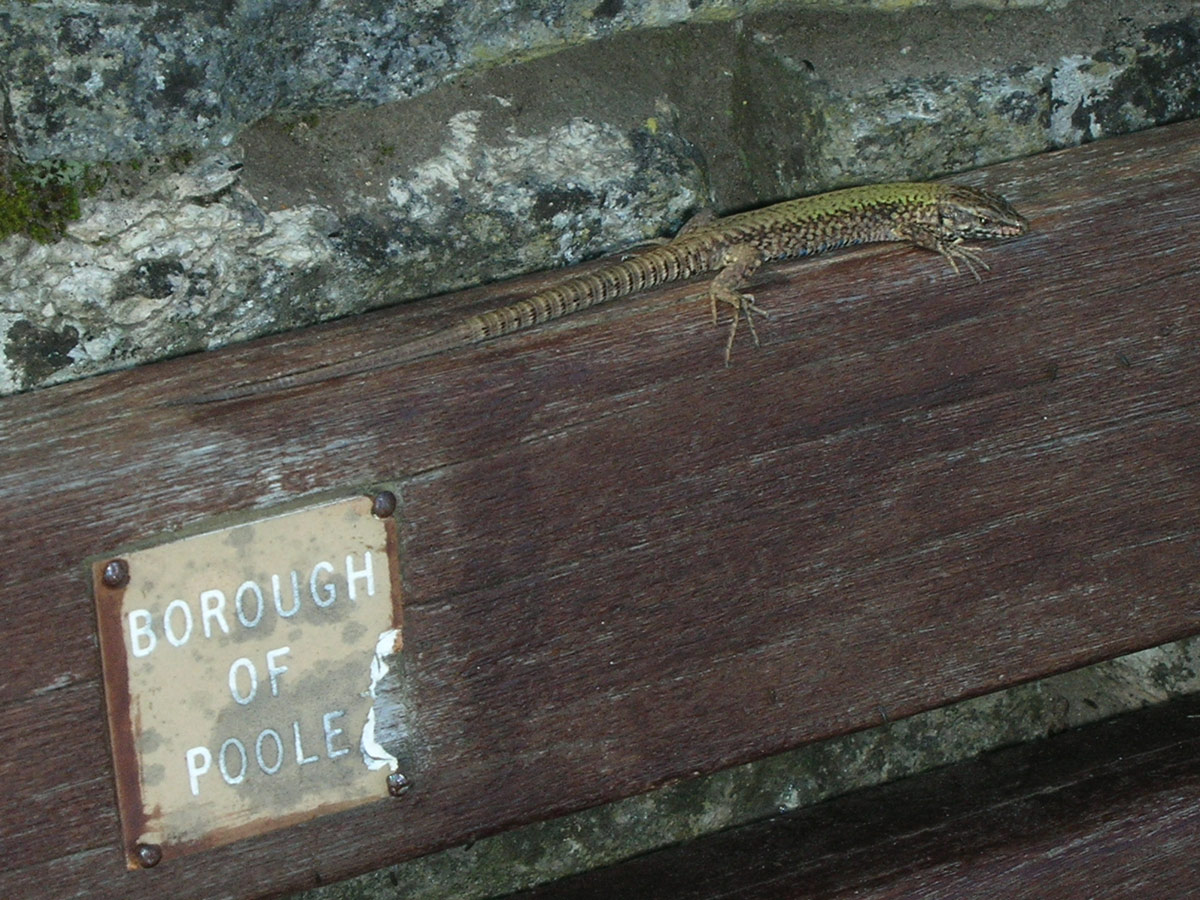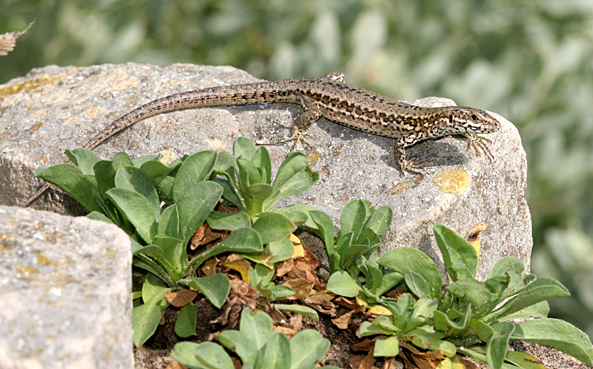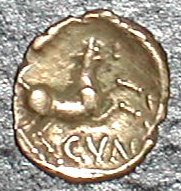 |
 |
Wall Lizard [I]Podarcis muralis[/I]: |
| Author | Message |
|
David Bird Forum Specialist Joined: 17 Feb 2003 No. of posts: 515 View other posts by David Bird |
Posted: 11 Mar 2003 Dorset has several colonies of Wall Lizard that seem to have been fairly recently set up (less than 10 years). Several of these are in fairly isolated areas with very few native reptiles. One however is in an area where Sand Lizards used to occur. These now have not been seen for a number of years although the habitat is difficult to survey and it is not known if they are still present in areas where one cannot reach or if habitat changes that have occured may be responsible for their disappearance. Habitat management has been carried out recently and a more thorough survey will be made in the spring. Has anyone else seen any reduction in native reptile species where Wall Lizards are now found British Herpetological Society Librarian and member of B.H.S Conservation Committee. Self employed Herpetological Consultant and Field Worker. |
|
Martin Senior Member Joined: 23 Feb 2003 No. of posts: 87 View other posts by Martin |
Posted: 10 Apr 2003 Dave, there are apparently a few fairly naturalised groups of wall lizards around, is this legal?! How do you feel about publicising sites of introductees?? |
|
David Bird Forum Specialist Joined: 17 Feb 2003 No. of posts: 515 View other posts by David Bird |
Posted: 10 Apr 2003 The release of any non native species is against the law. Wildlife & Countryside Act 1981 Pt 1 section 14 (1) Subject to the provisions of this part, if any person releases or allows to escape into the wild any animal which- (a) is of a kin which is not ordinarily resident in and is not a regular visitor to Great Britain in a wild state; or (b) is included in Part 1 of schedule 9. he shall be guilty of an offence. The common Wall Lizard is on the list in Pt.1 of schedule 9. of animals which are established in the wild. From a personal point of view I do not consider that colonies that are on the coast on rocky cliffs or on shingle beaches and garden walls are a threat to any native species. Some people have tried to proove that some populations are relict native populations and as such should be given strictly protected status. I do not think the introduction onto heathland cliffs in Dorset where the endangered Sand Lizard lives was a good idea and I am rather worried that the Wall Lizard is thriving possibly at the expense of the Sand Lizard. Certainly with the Wall lizard the numbers of young that can be produced each year by a female I do not feel that if people do go to any of the sites and collect a few specimens to keep at home they are going to have much effect on the population. Obviously it is illegal and irresponsible to release any specimens caught anywhere else in the wild. British Herpetological Society Librarian and member of B.H.S Conservation Committee. Self employed Herpetological Consultant and Field Worker. |
|
Martin Senior Member Joined: 23 Feb 2003 No. of posts: 87 View other posts by Martin |
Posted: 11 Apr 2003 Thanks. |
|
Mick Member Joined: 10 Jun 2005 No. of posts: 184 View other posts by Mick |
Posted: 27 Aug 2005 Rejuvenating this thread after two years, but anyway.. Just wanted to say that IF i were to fancy keeping either Green lizards, or Wall lizards again, then as things seem to presently be standing with both those species along the Sand lizards fringe territory of the Bournmouth Cliffs, that's where i'd go & have little hesitation in noosing, or otherwise capturing a few. As nice as all these mixed species along there might appear, & as much as i most definately wouldn't harm as much as a single scale on the heads of any of them there, i personally would - as things stand there - consider taking Wall &/or Green lizards from there because of how these alien species there appear to be negatively impacting upon that areas native Sand lizards. Whoever the naive idiots were that released those alien species there deserve to be shot!,..the bu99ers!  I actually don't have a problem with these alien species existing elsewhere in locations in the UK (doubt they'd ever become that explosively populous) but certainly not wherever they competitively threaten our most fragile species. Walls & Greens are two of my most very favourite lizard species, but they don't belong - of all places - along the Bournemouth Cliffs. With Wall lizards being so agile & swift for catching insect prey on the one hand, & Green lizards being as swift as our Sand lizards but bigger than them on the other hand, the dwindling Sand lizards of the Bournemouth Cliffs sadly appear to be really up against it for survival there. At least three lizard species there is great,..just a pity that's not really the true & harmonious picture of things though. What'll give...? I actually don't have a problem with these alien species existing elsewhere in locations in the UK (doubt they'd ever become that explosively populous) but certainly not wherever they competitively threaten our most fragile species. Walls & Greens are two of my most very favourite lizard species, but they don't belong - of all places - along the Bournemouth Cliffs. With Wall lizards being so agile & swift for catching insect prey on the one hand, & Green lizards being as swift as our Sand lizards but bigger than them on the other hand, the dwindling Sand lizards of the Bournemouth Cliffs sadly appear to be really up against it for survival there. At least three lizard species there is great,..just a pity that's not really the true & harmonious picture of things though. What'll give...? |
|
Iowarth Admin Group Joined: 12 Apr 2004 No. of posts: 222 View other posts by Iowarth |
Posted: 29 Aug 2005 Much as I love Wall Lizards I am bound to agree that their introduction onto the Bournemouth Cliffs was arguably foolish. I haven't done any monitoring of La in the area in recent years but I do believe that Pm could have a detrimental effect in this type of habitat. Adults of both species will happily eat the young of both species BUT, an adult La would find a young Pm hard to catch AND, since, Pm regularly multi-clutch they produce more young per year. Being a more opportunistic lizard that can use a wider habitat range I believe a negative effect is inevitable - slowly but surely their success would be at the Sand Lizard's cost. BUT - this is simply an opinion based on the characteristics of the two species. Interestingly the same does not apply with Green Lizards. There is little difference in reproductive rate. From years of observing both in the wild and in captivity the Sand Lizard is far more agressive than the Green Lizard so I think the negative impact is lesser. It is also worth noting that there are significant barriers between the extant Green Lizard colony and the local Sand Lizards and we have no historical records of Sand Lizards in the area occupied by Green Lizards. We are looking into carrying out some research in the near future to more accurately assess the impact of both species, particularly the Green lizard, on the Sand Lizard.
Chris Davis, Site Administrator Co-ordinator, Sand Lizard Captive Breeding Programme |
|
herpetologic2 Senior Member Joined: 15 Jun 2004 No. of posts: 1369 View other posts by herpetologic2 |
Posted: 31 Aug 2005
As far as I can make out the days are numbered for the Sand Lizard on these cliffs -if I am looking at the right ones on www.getamap.co.uk - how would they fair without the green or wall lizard in this isolated habitat? JC Vice Chair of ARG UK - self employed consultant - visit ARG UK & Alresford Wildlife |
|
David Bird Forum Specialist Joined: 17 Feb 2003 No. of posts: 515 View other posts by David Bird |
Posted: 31 Aug 2005 Why do you say their days are numbered ? Is it just the isolation. Many Sand Lizard populations are isolated due to fragmentation but if the area is reasonably large which the cliffs are they do seem to survive and do well. There are some sites that I have been working on for the last 25 years that are a very small fraction of the size of the cliffs that are doing well and with correct habitat management are still increasing.The cliffs as a whole are an area of heathland that is larger than many heathland reserves which hold Sand Lizards. Sand Lizards in the U.K., in my view, are colonisers and as such probably always start with a fairly small gene pool and may suffer genetic bottlenecks quite naturally if the corridor they originally used closes. Do I infer that from your posting all isolated populations are doomed and should be left to die off or used for alien introductions. British Herpetological Society Librarian and member of B.H.S Conservation Committee. Self employed Herpetological Consultant and Field Worker. |
|
herpetologic2 Senior Member Joined: 15 Jun 2004 No. of posts: 1369 View other posts by herpetologic2 |
Posted: 31 Aug 2005
No I stand corrected - I am pleased that they can do well - Has it been determined that the sand lizards are purely 'native' - as the introduction of pet lizard species (walls & greens) may also have included sand lizards in the past from other parts of Europe? Though werent the Green lizards a recent introduction?
Vice Chair of ARG UK - self employed consultant - visit ARG UK & Alresford Wildlife |
|
Tony Phelps Forum Specialist Joined: 09 Mar 2003 No. of posts: 575 View other posts by Tony Phelps |
Posted: 31 Aug 2005 I agree with Dave, the La's on the cliffs are stable - they have suffered a decline further west; on one well known site Pool Borough has landscaped the area, to make it neat & tidy, duh 
Sand lizards pop up anywhere it seems, good places are many of the residential gardens around Parkstone Golf Course, and in amongst various caravan sites. Some of these areas were heavily collected in the past; Dave might remember, but in the late 1960s Keith Corbet and I remember seeing them for sale in Poole and Bournemouth pet shops, along with greens and walls, and grass snakes plus the odd smooth snake. T |
|
David Bird Forum Specialist Joined: 17 Feb 2003 No. of posts: 515 View other posts by David Bird |
Posted: 19 Aug 2006 As some of you will know from my previous posts I have never been happy with the release of the Wall Lizard Podarcis muralis on the Bournemouth and Poole cliffs due to its effect on the Sand Lizard population which has declined since the illegal introduction. There is a translation of a short german paper at http://www.lacerta.de/englische-Version/index-englis ch.html Go to Topics then Release and drifting to see the article titled "Do non-native Common Wall Lizards jeopardize native Sand Lizards & Viviparous Lizards" by Detlef Munch. This may be of interest to some of you. David British Herpetological Society Librarian and member of B.H.S Conservation Committee. Self employed Herpetological Consultant and Field Worker. |
|
David Bird Forum Specialist Joined: 17 Feb 2003 No. of posts: 515 View other posts by David Bird |
Posted: 28 Aug 2007 Went to the Poole cliffs last week as I now have some work there saw more Wall Lizards than I could count. One small area of breeze blocks about 2m x 1m with holes in had 15 animals out basking nearly all adults may be so dense that they are not being territorial.Every rock in a rockery seemed to have an adult associated with it 
This specimen was so tame in a sunken garden on the cliffs it licked my finger when I put it carefully near it. British Herpetological Society Librarian and member of B.H.S Conservation Committee. Self employed Herpetological Consultant and Field Worker. |
|
Vicar Senior Member Joined: 02 Sep 2004 No. of posts: 1181 View other posts by Vicar |
Posted: 28 Aug 2007 HI David, welcome back to the forum ! You didn't have any strawberry jam on your finger did you? (winks at Gemma  ) )It's amazing just how prolific these lizards can be; In June I was in France, and found a 'colony' inhabiting the stone base of a road-junction crucifix. I estimated around ten animals per square metre of basking area, but not one animal away from the stepped stone base, in the nearby fields or hedges. It must be a very isolated (and possibly inbred) colony. I happened to be in Boscombe last Thursday, and this one posed conveniently :P  Steve Langham - Chairman 
Surrey Amphibian & Reptile Group (SARG). |
|
Alex2 Senior Member Joined: 16 Dec 2006 No. of posts: 266 View other posts by Alex2 |
Posted: 06 Sep 2007 Now that Sand Lizards appear to be virtually extinct along the Branksome cliff, it's a shame that this habitat could not be filled with carefully selected C.austriaca...Prime habitat, best part of it unreachable to human disturbance, and also more food than they could ever consume ;) . Would be almost perfect. *Edit - That's ONLY if the Agilis were extinct of course!. |
|
Vicar Senior Member Joined: 02 Sep 2004 No. of posts: 1181 View other posts by Vicar |
Posted: 06 Sep 2007 Alex, Had to laugth at that one...I've said the same, many a time :P  Steve Langham - Chairman 
Surrey Amphibian & Reptile Group (SARG). |
|
Alex2 Senior Member Joined: 16 Dec 2006 No. of posts: 266 View other posts by Alex2 |
Posted: 06 Sep 2007 You mean I'm not the only one with silly ideas Steve?!!. Ideally there'd be a way back for the agilis but sadly i'm not so sure now... |
|
Alex2 Senior Member Joined: 16 Dec 2006 No. of posts: 266 View other posts by Alex2 |
Posted: 12 Feb 2008 8 males and 1 female Podarcis seen at Worth from 1:40pm today, also 4 Z.vivipara. Nice sunny conditions, but there was still a chilly coastal breeze. |
|
Vicar Senior Member Joined: 02 Sep 2004 No. of posts: 1181 View other posts by Vicar |
Posted: 12 Feb 2008 Hi Alex, not too sure about the geography of that region (Worth?)...was this Canford Cliffs area ? Steve Langham - Chairman 
Surrey Amphibian & Reptile Group (SARG). |
|
AGILIS Senior Member Joined: 27 Feb 2007 No. of posts: 694  View other posts by AGILIS |
Posted: 13 Feb 2008 what is the earliest known recordings of wall lizards in the Bournmouth /Poole cliff areas, is there a possilbity that they might be native species that have been taken for granted by local people with less expierience & assumed that they were la or greenish vips and only been noticed in the area in recent times by more enlightened herp followers who are more mobile these days. Also when do you think they may have been introduced to the cliff areas ? .just a thought ? what is the earliest known recordings of wall lizards in the Bournmouth /Poole cliff areas, is there a possilbity that they might be native species that have been taken for granted by local people with less expierience & assumed that they were la or greenish vips and only been noticed in the area in recent times by more enlightened herp followers who are more mobile these days. Also when do you think they may have been introduced to the cliff areas ? .just a thought ? Keith Keith
LOCAL ICYNICAL CELTIC ECO WARRIOR AND FAILED DRUID |
|
Vicar Senior Member Joined: 02 Sep 2004 No. of posts: 1181 View other posts by Vicar |
Posted: 13 Feb 2008 Hi Keith, Not native..deliberately introduced (1990s). Closest native animals are in France & Channel islands, which are brown-backed, not the Italian green-backed form that is so common in the UK. The only UK colony that I don't have some information on the actual introduction is the Isle of Wight c1920s, but they are green-backed animals, so see point one. Steve Langham - Chairman 
Surrey Amphibian & Reptile Group (SARG). |
- Wall Lizard [I]Podarcis muralis[/I] |